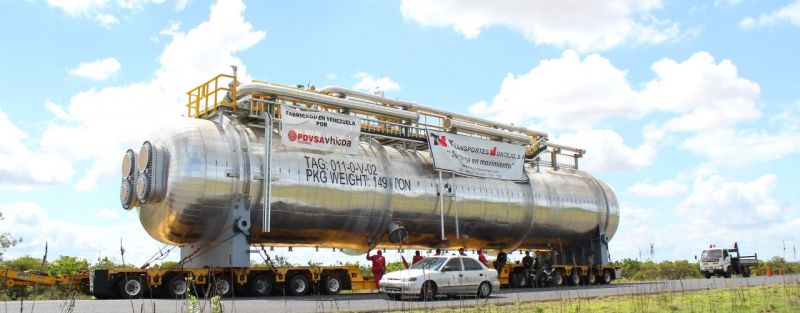Mega-structures for Oil Crude Desalination
Published on by Water Network Research, Official research team of The Water Network in Technology
Petróleos de Venezuela, S.A. (PDVSA) completed successfully the land transfer of two mega-structures, from Bolívar to Anzoátegui states, for oil crude desalination.
Both mega-structures were built by Venezuelan talent in VHICOA workshops, a joint venture of the subsidiary PDVSA Industrial, within the framework of the plans to increase the Corporation productive capabilities.

Image Source: PDVSA
These teams will be an integral part of Petromonagas (PDVSA/Rosneft) Facility Center for Early Production. It is a project with a process report of 65 percent, located in the heart of Hugo Chávez Orinoco Oil Belt, Carabobo Division, with the participation of Schlumberger.
VHICOA built these two identical containers of 149 weight tons, 25 meters long and 6.5 meters high in a period of time of 11 months, in order to guarantee the processing of 52 thousand oil barrels per day (MBD), in addition to the current production of Operational Center Petromonagas (COPEM), presently estimated in 130 MBD. The main function of both desalination plants is the subtraction of water and salt contained in heavy oil crude.
This oil crude processing modular center shall be added to COPEM, once Schlumberger, the main contractor, ends the Engineering, Procurement and Construction (EPC), in February 2019, with the view to leverage early production of Petrovictoria, another PDVSA and Rosneft’s joint venture, currently with a Production of 10 MBD.
These oil crude desalters were certified by inspectors from the American Society of the Mechanical Engineers (ASME), coming from Colombia, Mexico, Brazil and the USA. They checked out the excellent state of the welds, which is vital for the 22 millimeters thick steel sheet joints, with a capability to bear very high pressures and temperatures.
As part of this project, VHICOA, a joint venture, specialized in the field of the mechanical metallurgy, gave to PDVSA Petromonagas a 16 meters high and 5 meters wide three-phase separator of gas, water and oil crude.
The scope of this effort included another gas separator (a piece called KOD) of minor dimensions, with 33 tons weight, 13 meters long, 4 meters wide and 6 meters high.
A total of 50 workers took part of each equipment recipient manufacture, structures, platforms, thermal insulation, electricity and instruments, and piping assembly. About 55 thousand working hours were spent in the whole Project.
An unprecedented Land Transfer
Once the fabrication and packaging phases were concluded, transfer logistics guaranteed the delivery of those oil equipments to their final destination, from VHICOA workshops, located in Ciudad Guayana industrial area, Bolívar state, to Independencia municipality, Anzoátegui state, Carabobo division, where Petromonagas, the joint venture composed by PDVSA and its Russian partner Rosneft work on the oil crude early production strategy from a multiple system of “clusters” nature.
Along with Transportes Montejo international company, specialized in heavy and extra-heavy lifting and transfer load, bridges were reinforced and high and medium voltage lines, roads width, trees and traffic lines were checked, among other key aspects of such a logistics rarely seen, along a total travel of 120 kilometer, with the view to avoid any possible incident. Likewise, a special road safety raid with the support of the National Bolivarian Guard (GNB) was designed to control the road traffic along the whole way.
Three days took the transfer, at 20 kilometers maximum speed per hour, with a total load transferred of over 268 tons.
These two new desalters manufacture, to back up crude oil production increasing in Hugo Chávez Orinoco Oil Belt, represent another success to the one already achieved last September, with the transfer of two other equipments of a deeper draft and “packaged” (process piping, sensors, electrical parts and transformers among others are included) for Deep Conversion Project, currently under construction in Puerto La Cruz Refinery.
Source: PDVSA
Media
Taxonomy
- Oil & Gas
- Decontamination
- Technology
- Desalination
- Produced Water From Oil & Gas Industry
- Industrial Oil
- Oil Field Chemicals
- Oil & Gas
- Desalination
- Oil & Gas